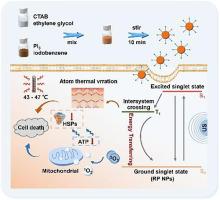当前位置:
X-MOL 学术
›
Chem. Eng. J.
›
论文详情
Our official English website, www.x-mol.net, welcomes your
feedback! (Note: you will need to create a separate account there.)
A mild and efficient sonothermal tumor therapy enhanced by sonodynamic effect with biodegradable red phosphorus nanoparticles
Chemical Engineering Journal ( IF 13.3 ) Pub Date : 2024-01-12 , DOI: 10.1016/j.cej.2024.148711 Zhizi Ma , Meng Yuan , Ziyong Cheng , Zhuang Yang , Ling Yang , Bin Liu , Yulong Bian , Abdulaziz A. Al Kheraif , Ping'an Ma , Jun Lin
Chemical Engineering Journal ( IF 13.3 ) Pub Date : 2024-01-12 , DOI: 10.1016/j.cej.2024.148711 Zhizi Ma , Meng Yuan , Ziyong Cheng , Zhuang Yang , Ling Yang , Bin Liu , Yulong Bian , Abdulaziz A. Al Kheraif , Ping'an Ma , Jun Lin

|
Due to the shallow penetration depth of light in biological tissues, the effectiveness of photothermal therapy (PTT) in deep-seated tumors is limited. Conversely, ultrasonic wave has excellent tissue penetration depth. Using ultrasound (US) as an exogenous physical stimulus to trigger tumors thermotherapy is a promising alternative for deep-seated tumors to supersede conventional PTT. Here, we realized a mild sonothermal therapy (STT) using biodegradable red phosphorus nanoparticles (RP NPs) as sonothermal agents. Quite obvious sonothermal conversion of RP NPs is remarkable under low intensity US irradiation, with the temperature rise from 30 to 47 °C at tumor site. In terms of potential mechanism, under US excitation, the internal electrons of RP NPs undergo transition and release the energy by electrons and holes recombination process. This elicits the atom thermal vibration and raises the temperature around the RP NPs. Additionally, US irradiation can stimulate RP NPs to produce singlet oxygen (1 O2 ) and reduce intracellular energy levels that leads to downregulation of the heat shock proteins (HSPs) expression, providing an “escort” to mild STT. This work offers a new paradigm for the strategies of STT enhanced by sonodynamic effect.
中文翻译:

通过可生物降解的红磷纳米粒子的声动力效应增强温和有效的声热肿瘤治疗
由于光在生物组织中的穿透深度较浅,光热疗法(PTT)对深部肿瘤的疗效有限。相反,超声波具有极好的组织穿透深度。使用超声波 (US) 作为外源性物理刺激来触发肿瘤热疗是替代传统 PTT 的一种很有前景的替代疗法。在这里,我们使用可生物降解的红磷纳米颗粒(RP NP)作为声热剂实现了温和的声热疗法(STT)。在低强度US照射下,RP NPs的声热转化非常明显,肿瘤部位的温度从30°C上升到47°C。从潜在机制来看,在US激发下,RP NPs的内部电子发生跃迁,并通过电子和空穴复合过程释放能量。这引发了原子热振动并提高了 RP NP 周围的温度。此外,US辐射可以刺激RP NP产生单线态氧(1O2)并降低细胞内能量水平,从而导致热休克蛋白(HSP)表达下调,为轻度STT提供“护航”。这项工作为声动力效应增强的 STT 策略提供了新的范例。
更新日期:2024-01-12
中文翻译:

通过可生物降解的红磷纳米粒子的声动力效应增强温和有效的声热肿瘤治疗
由于光在生物组织中的穿透深度较浅,光热疗法(PTT)对深部肿瘤的疗效有限。相反,超声波具有极好的组织穿透深度。使用超声波 (US) 作为外源性物理刺激来触发肿瘤热疗是替代传统 PTT 的一种很有前景的替代疗法。在这里,我们使用可生物降解的红磷纳米颗粒(RP NP)作为声热剂实现了温和的声热疗法(STT)。在低强度US照射下,RP NPs的声热转化非常明显,肿瘤部位的温度从30°C上升到47°C。从潜在机制来看,在US激发下,RP NPs的内部电子发生跃迁,并通过电子和空穴复合过程释放能量。这引发了原子热振动并提高了 RP NP 周围的温度。此外,US辐射可以刺激RP NP产生单线态氧(1O2)并降低细胞内能量水平,从而导致热休克蛋白(HSP)表达下调,为轻度STT提供“护航”。这项工作为声动力效应增强的 STT 策略提供了新的范例。


















































 京公网安备 11010802027423号
京公网安备 11010802027423号